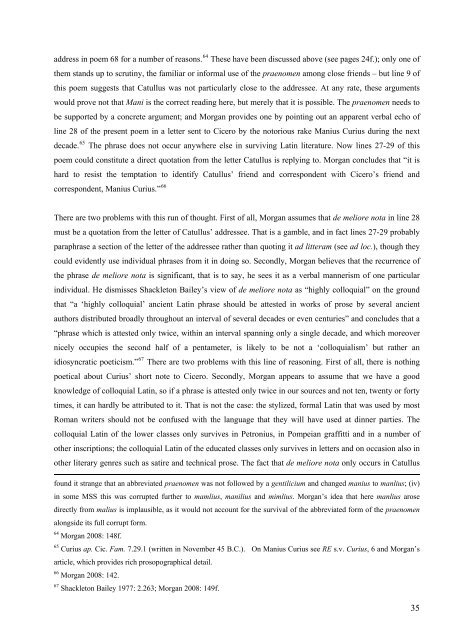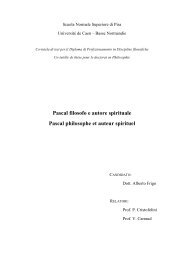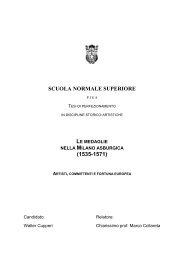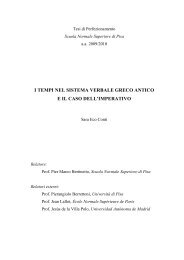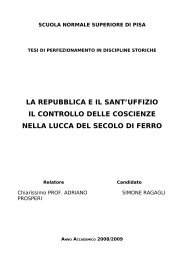CATULLUS 68 - Scuola Normale Superiore
CATULLUS 68 - Scuola Normale Superiore
CATULLUS 68 - Scuola Normale Superiore
You also want an ePaper? Increase the reach of your titles
YUMPU automatically turns print PDFs into web optimized ePapers that Google loves.
address in poem <strong>68</strong> for a number of reasons. 64 These have been discussed above (see pages 24f.); only one of<br />
them stands up to scrutiny, the familiar or informal use of the praenomen among close friends – but line 9 of<br />
this poem suggests that Catullus was not particularly close to the addressee. At any rate, these arguments<br />
would prove not that Mani is the correct reading here, but merely that it is possible. The praenomen needs to<br />
be supported by a concrete argument; and Morgan provides one by pointing out an apparent verbal echo of<br />
line 28 of the present poem in a letter sent to Cicero by the notorious rake Manius Curius during the next<br />
decade. 65 The phrase does not occur anywhere else in surviving Latin literature. Now lines 27-29 of this<br />
poem could constitute a direct quotation from the letter Catullus is replying to. Morgan concludes that “it is<br />
hard to resist the temptation to identify Catullus’ friend and correspondent with Cicero’s friend and<br />
correspondent, Manius Curius.” 66<br />
There are two problems with this run of thought. First of all, Morgan assumes that de meliore nota in line 28<br />
must be a quotation from the letter of Catullus’ addressee. That is a gamble, and in fact lines 27-29 probably<br />
paraphrase a section of the letter of the addressee rather than quoting it ad litteram (see ad loc.), though they<br />
could evidently use individual phrases from it in doing so. Secondly, Morgan believes that the recurrence of<br />
the phrase de meliore nota is significant, that is to say, he sees it as a verbal mannerism of one particular<br />
individual. He dismisses Shackleton Bailey’s view of de meliore nota as “highly colloquial” on the ground<br />
that “a ‘highly colloquial’ ancient Latin phrase should be attested in works of prose by several ancient<br />
authors distributed broadly throughout an interval of several decades or even centuries” and concludes that a<br />
“phrase which is attested only twice, within an interval spanning only a single decade, and which moreover<br />
nicely occupies the second half of a pentameter, is likely to be not a ‘colloquialism’ but rather an<br />
idiosyncratic poeticism.” 67 There are two problems with this line of reasoning. First of all, there is nothing<br />
poetical about Curius’ short note to Cicero. Secondly, Morgan appears to assume that we have a good<br />
knowledge of colloquial Latin, so if a phrase is attested only twice in our sources and not ten, twenty or forty<br />
times, it can hardly be attributed to it. That is not the case: the stylized, formal Latin that was used by most<br />
Roman writers should not be confused with the language that they will have used at dinner parties. The<br />
colloquial Latin of the lower classes only survives in Petronius, in Pompeian graffitti and in a number of<br />
other inscriptions; the colloquial Latin of the educated classes only survives in letters and on occasion also in<br />
other literary genres such as satire and technical prose. The fact that de meliore nota only occurs in Catullus<br />
found it strange that an abbreviated praenomen was not followed by a gentilicium and changed manius to manlius; (iv)<br />
in some MSS this was corrupted further to mamlius, manilius and mimlius. Morgan’s idea that here manlius arose<br />
directly from malius is implausible, as it would not account for the survival of the abbreviated form of the praenomen<br />
alongside its full corrupt form.<br />
64<br />
Morgan 2008: 148f.<br />
65<br />
Curius ap. Cic. Fam. 7.29.1 (written in November 45 B.C.). On Manius Curius see RE s.v. Curius, 6 and Morgan’s<br />
article, which provides rich prosopographical detail.<br />
66<br />
Morgan 2008: 142.<br />
67<br />
Shackleton Bailey 1977: 2.263; Morgan 2008: 149f.<br />
35


